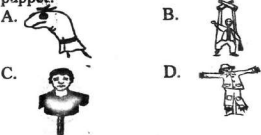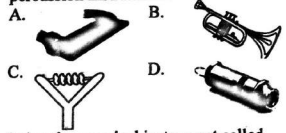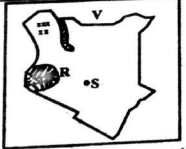ART/CRAFT.
- All the following materials may be needed for thonging except a
- belt.
- leather.
- mallet.
- Knife.
- Which of the following indigenous crafts can be woven?
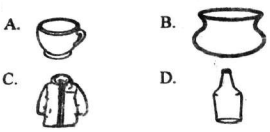
- Mundia drew a picture like the one drawn below.
The type of drawing above is called- observation drawing
- imagination drawing.
- stationary drawing.
- still life drawing.
- Komboyo wants to practice crayon etching technique. Which of the following pairs of items does he need?
- Black ink, celotape.
- Toothpick, plasticine.
- Black ink, beeswax.
- Paraffin wax, plasticine.
- Which of the following lists consists of items needed when making an expandable folder?
- Manila paper, ruler, glue.
- Pencil, needle, crayon.
- Water, scissors, cotton wool.
- Soap, eraser, glue.
- Study the diagram below.
Light and dark effects have been created using- stippling technique.
- smudge technique.
- crayon etc ing technique.
- cross hatching technique.
- When mounting artwork, what is the use of adhesives?
- Making the frame.
- Decorating the cutouts.
- Cutting out pictures.
- Sticking the cutouts.
- Clay items cannot be decorated using
- stamping.
- scratching.
- pasting.
- incising.
- Which of the following shows a glove puppet?
- Painting or. fabric can be done using
- needles.
- sponges.
- wires.
- sticks.
MUSIC.
- Which of the following French rhythms represents short sounds
- Ta-te
- Taa
- Taa - taa
- Taa-aa
- Below is an example of a percussion instrument.
The instrument above cannot be tuned by- tightening the laces.
- exposing the membrane to the heat from fire.
- adjusting the bridge.
- putting it in the sun.
- All the following members of the community can practice folk dances except
- men.
- women.
- boys.
- babies.
- A group of learners was asked to mention some items that can be used to improvise a drum.
Mercy: - clay.
Alice: - sand.
Lucy: - Log.
Joyce: - Wire.
Who among the learners mentioned a correct item?- Mercy
- Lucy
- Alice.
- Joyce.
- The East African Community Anthem is usually sung in
- mother tongue.
- English.
- Kiswahili.
- English and Kiswahili.
- Head joints and middle joints are parts of a
- guitar.
- descant recorder.
- flute.
- drum.
- Which of the following is an example of a percussion instruments.
- Below is a musical instrument called nzumari.
The instrument drawn above is played by the- Abakuria.
- Ameru
- Abagusii.
- Mijikenda.
- Which of the following hand signs represents solfa name re?
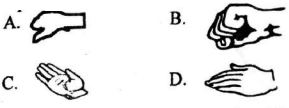
- Which of the following lines is found in the third verse of the Kenya National Anthem?
- With hearts both strong and true.
- In common bond united.
- Firm may we stand to defend.
- Justice be our shield and defender.
SOCIAL STUDIES.
- All the following are not cardinal points of a compass except
- south east.
- north west.
- south.
- south west.
- Sanaipei was asked to name an industry that deals in wheat products. Which of the following would be the correct response from Sanaipei?
- Fruit canning industry.
- Bakery industry.
- Creamery industry.
- Sawmill industry.
- The diagram below represents a type of population
The type of population represented above can be described as- straight.
- scattered.
- clustered.
- linear.
- Who among the following people depend on each other for the exchange of goods with money?
- Teachers and pupils.
- Traders and buyers.
- Police officers and thugs.
- Children in school.
- The county government gets its money from all the following sources except
- dues paid by tourists visiting the counties.
- money from land rates.
- rents from county offices.
- grants from the national government.
- Who among the following leaders in children's government in school maintains order in the classroom?
- President
- Games president
- Class representative
- Deputy president
- A situation where a child is forced to do hard work and is underpaid is called
- human rights.
- child abuse.
- child labour.
- interdependence.
- All the following are aspects of our traditional culture. Which one is not?
- The foods we eat.
- Our religions.
- The way we build our houses.
- The curriculum we follow in school.
- A cultural centre is an example of
- historic built environments.
- recreation facilities..
- physical features.
- permanent buildings.
- During rainy seasons,
- farmers harvest their farm produce.
- farmers carry out weeding in their farms.
- animals do not get sufficient pasture.
- there's no adequate water for domestic and farm uses.
- Below is a source of heat.
Which of the following fuels can best be used with the item above?- Firewood
- Charcoal
- Diesel
- paraffin
Use the map of Kenya below to answer questions 32 to 35
- The country marked V is most likely to be
- Sudan.
- Tanzania.
- Somalia.
- Ethiopia.
- The mountain marked S is called mount
- Kenya.
- Marsabit.
- Kulal.
- Longonot.
- The relief region marked R is the
- Lake basin.
- Nyika plateau.
- Rift Valley.
- Highlands.
- The main language group that lives in the area marjked xxx is
- Bantu.
- Nilotes.
- Semites.
- Cushites.
CHRISTIAN RELIGIOUS EDUCATION
- Who among the following was a dreamer according to the Bible?
- Pharaoh
- Joseph
- Jesus
- Moses
- The king who asked for wisdom from God was king
- Nebchadnezzar.
- Ahab.
- Saul.
- Solomon.
- Jesus Christ performed all the following miracles except
- changing water into wine.
- turning a stick into a snake.
- walking on water.
- Raising the dead.
- Selfishness means
- taking care of you and your friends.
- thinking about your neighbours.
- thinking only about yourself.
- helping other people whenever they need your help.
- The first book in the New Testament is called
- Genesis.
- Matthew.
- Malachi.
- Revelation.
- People of Israel were slaves in Egypt under
- Pharaoh.
- Moses.
- Pharisees.
- Joshua.
- Joseph's brothers hated him because he was
- given a coat of many colours.
- a young handsome man.
- liked most by Jacob their father.
- a close friend to Pharaoh.
- In order for Zacchaeus to see Jesus, he
- told the people in the crowd to give way.
- climbed a tree.
- used a tall ladder.
- ran ahead of the multitude.
- Abraham wanted to sacrifice his son called
- Isaac
- Samuel
- Paul
- Jonathan
- Jesus used __________________________ to teach people.
- proverbs
- stories
- riddles
- parables
- All the following are good practices for a Christian. Which one is not?
- Respecting one another.
- Helping the old.
- Abusing our enemies.
- Visiting the sick.
- The Philistine giant killed by David was called
- Goliath.
- Belshaazar.
- Pharaoh.
- Naboth.
- When Jesus raised the dead, He portrayed His power over
- diseases
- people
- death
- satan
- When the big fish vomited Jonah, he went and preached in the city of
- Tarshish.
- Capernaum.
- Caisea.
- Nineveh.
- Before Jesus calmed the storm, He was
- sleeping.
- preaching.
- fasting.
- praying.
ISLAMIC RELIGIOUS EDUCATION
- Which of the following is referred to as the opening chapter in the Qur'an?
- Al-Nasr
- Al-Walid
- Al-Kariim
- Al-Fatiha
- Surah An-Nas means the
- men.
- wind.
- dawn.
- elephants.
- I recite Al-Muawwidhatayan before I
- play.
- wake up.
- sleep.
- eat.
- All the following lessons are learnt in surah Al-Ikhlas except
- evil people have bad endings.
- Allah is one.
- Allah is unique.
- Allah controls all things.
- All the following are positive uses of social media. Which one is not?
- Listening to Qasida from a mobile phone.
- Creating dawah groups on Whatsapp.
- Sending abusive messages to those who wrong us.
- Sharing homework questions using smart phones.
- Which among the following is a vice?
- Humility
- Obedience
- Kindness
- Selfishness
- Who among the following angels is responsible for record taking?
- İsrafil
- Raqib
- Izrail
- Munkar
- Surah Al-Lahab can also be called
- Al-Walid.
- Al-Kariim.
- Al-Masad.
- An-Nas.
- The fourth swalah of the day is called
- Fajr.
- Asr.
- Dhuhr.
- Maghrib.
- When eating our food, we should
- eat it while standing to save time.
- use the right hand as advised by prophet Muhammad (SAW)
- cat from the middle of the plate.
- be sending Qur'an verses to our friends using our mobile phones.
- Praying is a way of
- securing a good place in paradise.
- speaking to Allah.
- drawing nearer and nearer to Allah.
- strengthening our faith in the religion.
- Which one of the following Islamic festivals is celebrated during childbirth?
- Milaud-un-Nabii.
- Eid-ul-Adhha.
- Aqiqah.
- Eid-ul-Fitr.
- How many pillars of Iman are there in the Muslim religion?
- Three.
- Four.
- Five.
- Six.
- Which one of the following is not an example of akhlaq?
- Feeding domestic animals.
- Protecting seedlings.
- Spending our money.
- Grazing animals.
- Which one ofthe following practices enables us observe hygiene?
- Taking wudhu
- Praying
- Helping the needy
- Fasting

MARKING SCHEME
- A
- C
- D
- C
- A
- D
- D
- C
- A
- B
- A
- C
- D
- B
- C
- B
- A
- D
- C
- B
- C
- B
- D
- B
- A
- C
- C
- D
- A
- B
- B
- D
- A
- A
- C
C.R.E
- B
- D
- B
- C
- B
- A
- C
- B
- A
- D
- C
- A
- C
- D
- A
I.R.E
- D
- A
- C
- A
- C
- D
- B
- C
- D
- B
- B
- C
- D
- C
- A
Join our whatsapp group for latest updates
Tap Here to Download for 30/-
Get on WhatsApp for 30/-
Download Creative Arts & Social Studies Questions and Answers - Grade 5 End Term 1 Exams 2023 Set 1.
Tap Here to Download for 30/-
Get on WhatsApp for 30/-
Why download?
- ✔ To read offline at any time.
- ✔ To Print at your convenience
- ✔ Share Easily with Friends / Students



